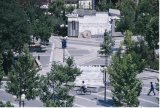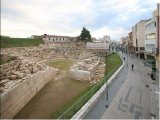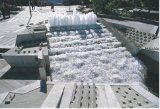E-CLIC Case Study #8
Larissa
1. Description and context; a brief introduction
“Total art operations for the reestablishment of the natural, historical and cultural landscape of the city of Larissa”. The project has been promoted by the Municipality of Larissa, and aims to create a new landscape identity for the city based on the enhancement of the ancient Theatre. It intends to do so by involving local communities and revealing the memories of a distinctive agricultural landscape such as the plain of Thessaly with the Pinios river. The project implements the principles defined under the ELC (2010) through local urban planning.
2. Country
Greece
3. Location
Larissa (Central Greece- Thessaly)
4. Year
2006
5. Landscape Type
Urban
6. Policy associated with (please note if this project is part of a wider sustainable development strategic and political framework)
The project is associated with the general strategic policy of the Municipality of Larissa to reveal the ancient theatre (3rd Century BC) of the city and to reform city centre.
7. Policy target associated with the implementation of the project:
7.1 Type of target
Planning
7.2 Description of the concrete targets
The project aims to create a new identity for the city of Larissa based on the enhancement of the city’s Ancient Theatre. The two main squares of the town, the central (Sapka) and Post Office square (Tahidromiou), are included in a holistic design approach, to highlight the temporal historical character of Larissa. To achieve these goals, the masterplan proposes the design of “the sculpted river”, marking the lost relationship between the city with its river (Pinios), and emphasizing the different landscape types of Thessaly (the uplands and the lowlands) along its route.The “the sculpted river” flows towards the Ancient Theatre and enables the development of the mountainous and lowland flora of the region.
8. Implementing agents
8.1 Main actors involved
The Masterplan was commissioned and supervised bythe Municipality of Larissa, Technical Service Department (Ms Vayoula Tsopanoglou). The townscape project was developed by the Landscape Sculptor Ms Nella Golanda (www.sculpted-architectural-landacapes.gr).
8.2 Funding
All funds for the masterplan and implementation of the project have been obtained from the Sectoral Operational Program about Thessaly and from local funding.
8.3 Public participation
A public participation process was embedded through the development of the project, and process of construction. Local craftsmen and art students from the Free Workshop of Fine and Applied Arts of Art Gallery of Larissa (Museum Katsigra)were involved during the construction of mosaic duplicates of the originals, which were found during the excavation of the center of Larissa.
9. Contributions to the specific measures proposed by the ELC
Awareness Raising
10. The challenge
The challenge is to enhance public awareness of the historical landscape of Larissa, and to achieve sustainable development based on a balanced and harmonious relationship between social needs, economic activity, culture and the environment. It aims to alter the landscape character of big cities and to raise consciousness amongst citizens of the local historical characteristics of their town. A further challenge is to educate people, especially children, that the landscape is a key element of individual and social well-being and that its protection, management and planning entail rights and responsibilities for everyone.
11. The solution
11.1 Measures and actions proposed to address the project challenges
An aim of the Masterplan is to increase people’s awareness about the relationship of the city of Larissa with its historical and mythical Pinios River (e.g. floods, natural disasters and bombings) and to re-establish this connection. It also aims to “prepare” the city centre for the accommodation of the revealed Ancient Theatre, which is located a short distance from the central square.
i)Post office squarerepresents the strong water flows from the mountains of Thessaly, guided by three sections of the “sculpted river” (local loops) to the Ancient Theatre. It represents the landscape of the uplands of Thessaly.
The plant species have been to create an appropriate atmosphere.The designer has emphasised the archaeological value of the city’s underground by incorporating 24 replicas of floor mosaics, from the Archaeological Museum, into areas of seating. Information points are located close to the seating, providing details about the address (name and number of the street), where these are found, and the year of their excavation.
ii)Central (Sapka) squarerepresents the landscape of lowlands of Thessaly and is designed to create an impression of this type of landscape. The planting design has taken account of the choice of plant size, and here the river appears with high strong waterflow providing the potential of light refraction, during the day and night.
The design of the features is to be consistent with the intended perspective, with benches designed in the form of bails of straw and lamp posts at an appropriate height.
The “sculpted river”is designed to convey a sense of the archaeological richness of the city, penetrating both the squares and giving the impression that the river crosses the city underground.
iii)The Ancient Theatre was highlighted by the holistic design of pedestrian improvements. The pavement design represents the groundplan of ancient buildings existing underground the city of Larissa, originating from the Neolithic era, through the Classical and the Byzantine Periods, creating a palimpsest of the presence of different civilizations.
i)Post office squarerepresents the strong water flows from the mountains of Thessaly, guided by three sections of the “sculpted river” (local loops) to the Ancient Theatre. It represents the landscape of the uplands of Thessaly.
The plant species have been to create an appropriate atmosphere.The designer has emphasised the archaeological value of the city’s underground by incorporating 24 replicas of floor mosaics, from the Archaeological Museum, into areas of seating. Information points are located close to the seating, providing details about the address (name and number of the street), where these are found, and the year of their excavation.
ii)Central (Sapka) squarerepresents the landscape of lowlands of Thessaly and is designed to create an impression of this type of landscape. The planting design has taken account of the choice of plant size, and here the river appears with high strong waterflow providing the potential of light refraction, during the day and night.
The design of the features is to be consistent with the intended perspective, with benches designed in the form of bails of straw and lamp posts at an appropriate height.
The “sculpted river”is designed to convey a sense of the archaeological richness of the city, penetrating both the squares and giving the impression that the river crosses the city underground.
iii)The Ancient Theatre was highlighted by the holistic design of pedestrian improvements. The pavement design represents the groundplan of ancient buildings existing underground the city of Larissa, originating from the Neolithic era, through the Classical and the Byzantine Periods, creating a palimpsest of the presence of different civilizations.
11.2 Degree of success in achieving the challenges
The biggest success was that Larissa has become the city in Greece which is the most beloved amongst its citizens, with a number of cultural thematic events along the Pinios River, and new groupings created with an aim of protecting of river’s history and landscape. In 2008, the pedestrianisation project of the Ancient Theatre was granted the first award of landscape architecture of archaeological sites by the Greek Association of Planners. In 2011, SADAS (the Panhellenic Union of Architects) organised a congress in Larissa with the title “Water: an important design tool for the contemporary cities”.
11.3 Main factors in the consecution of proposed objectives
The involvement of local communities throughout the process of the project.
12. Methodology proposed to reach the expected solution
12.1 Instruments used
The landscape design process of the project involved the following steps:
•Identify and evaluate the present situation of the landscape and the buildings
•Analyze the relationship of the historical centre with Pinios River in a broader geographical context
•Assess the elements and characteristics of the landscape of Thessaly
•Develop a master plan presenting the design concept based on total art
The primary design key concepts are:
-Human scale and local daily lifestyle incorporated into the design
-Space is treated as a habitable sculpture, creating the sense of a total art
-The new landscape becomes a landmark
-Exploration through design of the natural phenomena and rhythms
-Dialogue between historical and natural environment
-Revealing of the lost way of life in Mediterranean public spaces
-The experience offered by living in the heart of the total art sculptured spaces contributes to a daily communication with art, as well as enhancing human relations among the inhabitants and especially among children.
The key proposals, as identified in the Masterplan, seek to promote the historical identity of the city of Larissa and to re-establish the connection of the city with its river by a number of redesigned public spaces. Within these proposals, three public spaces have been designed in relation to each other and to the river. These projects of “art total” create an art consciousness among the users and especially the children, increasing awareness of the value of landscapes.
•Identify and evaluate the present situation of the landscape and the buildings
•Analyze the relationship of the historical centre with Pinios River in a broader geographical context
•Assess the elements and characteristics of the landscape of Thessaly
•Develop a master plan presenting the design concept based on total art
The primary design key concepts are:
-Human scale and local daily lifestyle incorporated into the design
-Space is treated as a habitable sculpture, creating the sense of a total art
-The new landscape becomes a landmark
-Exploration through design of the natural phenomena and rhythms
-Dialogue between historical and natural environment
-Revealing of the lost way of life in Mediterranean public spaces
-The experience offered by living in the heart of the total art sculptured spaces contributes to a daily communication with art, as well as enhancing human relations among the inhabitants and especially among children.
The key proposals, as identified in the Masterplan, seek to promote the historical identity of the city of Larissa and to re-establish the connection of the city with its river by a number of redesigned public spaces. Within these proposals, three public spaces have been designed in relation to each other and to the river. These projects of “art total” create an art consciousness among the users and especially the children, increasing awareness of the value of landscapes.
12.2 Participation process involved
In addition to the strong participation of local craftsmen and art students, this project is a good example of participation, supervision and management led by the public authority.
13. Lessons learnt
This project is an example of good practice of cooperation, in this case between the designer, the local authority and the citizens of Larissa. It illustrates that projects which obtain the participation of the general public, and local and regional authorities can prove successful. With active participation of the interested parties, as advocated by the ELC, it was more viable to identify this particular landscape throughout its territory. People realized that after this project their life has been improved, environmental restoration achieved, and tourism increased.
14. Key References
Giakoumakatos, Α. (2001).Architecture and Critique. Athens: Nefeli
Municipality of Larissa (2009). History Album: “Larissa 8.000 years of youth”. Larissa: Graphical art Lavdakis Ltd. (In Greek) Δήμος Λάρισας,(2009). Ιστορικό Λεύκωμα «Λάρισα 8.000 χρόνια νεότητας», Λάρισα: Γραφικές τέχνες Εμ. Λαβδάκης Ο.Ε.
Tetsis, S. (2013). Green movements in cities, policies for sustainable mobility. A European percpective. Athens: Papasotiriou (in Greek) Τσέτσης, Σ. (2013). Πράσινες μετακινήσεις στις πόλεις, Πολιτικές για μια βιώσιμη κινητικότητα. ΜΙΑ ΕΥΡΩΠΑΪΚΗ ΘΕΩΡΗΣΗ. Aθήνα:. Παπασωτηρίου.
Municipality of Larissa (2009). History Album: “Larissa 8.000 years of youth”. Larissa: Graphical art Lavdakis Ltd. (In Greek) Δήμος Λάρισας,(2009). Ιστορικό Λεύκωμα «Λάρισα 8.000 χρόνια νεότητας», Λάρισα: Γραφικές τέχνες Εμ. Λαβδάκης Ο.Ε.
Tetsis, S. (2013). Green movements in cities, policies for sustainable mobility. A European percpective. Athens: Papasotiriou (in Greek) Τσέτσης, Σ. (2013). Πράσινες μετακινήσεις στις πόλεις, Πολιτικές για μια βιώσιμη κινητικότητα. ΜΙΑ ΕΥΡΩΠΑΪΚΗ ΘΕΩΡΗΣΗ. Aθήνα:. Παπασωτηρίου.








